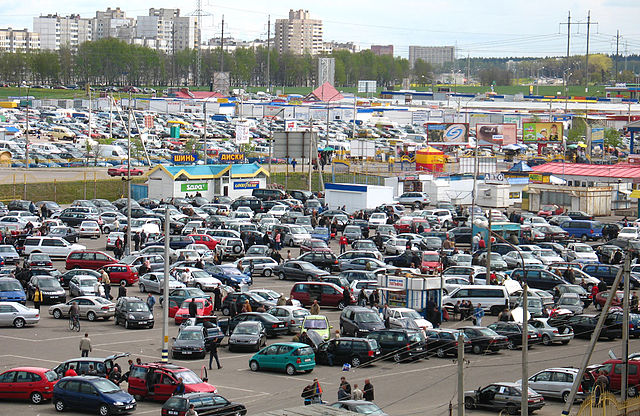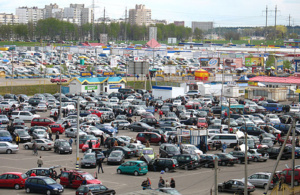2015 was very successful for the global automotive industry. The greatest results were achieved by automakers in the United States, which set a new sales record. Europe's leading German market showed the best result in six years. Rise in the industrialized countries compensated slowdown in the world's largest Chinese market and sharp reduction in sales in crisis countries such as Russia and Brazil.
US markets are waiting two record years in a row
Never have Americans purchased such a large number of new vehicles as in 2015. All the statistics has not been compiled yet, but it is already clear: the previous sales record of 17.41 million units, established in 2000, is beaten. According to estimates of the specialized publication Automotive News, a minimum of 17.42 million vehicles sold in the United States last year. Autodata Marketing Institute says that volume of sales even made 17.47 million.
Record demand for new cars is triggered by the economic recovery in the United States, which led to a decrease in unemployment and increase in household incomes and low credit rates. Cheap gasoline, reducing cost of car maintenance, also did its bit. Since all these factors are likely to remain for the foreseeable future, many experts believe that the American car market will set a new record in 2016. The December sales statistics show that by the end of last year, demand for cars clearly grew.
Particularly, Americans continue to enjoy off-road vehicles (SUV) and pick-ups, given that their producers have been paying increased attention to development of fuel-efficient engines in recent years. A wide range of such cars is traditionally offered by the "Big Three" American automakers - General Motors (GM), Ford and Chrysler, now owned by the Italian concern Fiat. At the end of 2015, all of them recorded sales growth very high for such a saturated market. Fiat-Chrysler showed best result, making itself a leader (7,3 percent).
Volkswagen: the first effects of the diesel scandal
The world's leading industry producer - Japanese corporation Toyota, is enjoying growing demand in the US, the second largest automobile market of the planet. Meanwhile, US sales of Europe's biggest carmaker, Germany Volkswagen, fell by 4.8 percent - to 349 thousand units - last year.
This is connected not only to the diesel scandal erupted in September 2015. Already in 2014, sales of the German company in the United States decreased by 10 percent, which indicates serious shortcomings in the company's marketing strategy. By the way, after another German automaker, Daimler, made sales record by selling more than 380,000 cars in the US market last year.
At the same time, despite the diesel scandal, Volkswagen has managed to increase sales of core brands on its native German market by 4.4 percent to almost 686,000 units. Thus, the group made a significant contribution to the overall growth of the German car market in 2015, amounting to 6 percent.
Germans are buying up imported cars
January 6, Association of the German Automotive Industry (VDA) reported that annual sales of new cars in Germany exceeded level of 3.2 million units for the first time in six years (in 2009, the Germans paid scrappage fee). Of these, 2.3 million were issued by German manufacturers, and 900 thousand – by foreign.
At the same time, production of passenger cars increased by more than 2 percent (up to 5.7 million). Thus, the German car industry is growing steadily, and the German car market is booming, largely due to a substantial increase in imports. As can be seen from VDA statistics, most vehicles produced in Germany are exported, primarily to the European Union. The market recorded a significant (according to preliminary data, more than 10 percent) sales growth in 2015 ( the UK and Spain in particular).
The largest foreign markets outside the EU are Chinese and American. In China, which is now rapidly slowing economic growth, the growth rate of new cars sales declined to about 3 percent in 2015. In 2016, Chinese experts forecast that the market will accelerate to 5-7 percent. This should be facilitated by introduction of tax incentives for cars with small displacement last October: VAT on them is reduced by half. This measure immediately resulted in a marked increase in sales in this market segment.
source: dw.de
US markets are waiting two record years in a row
Never have Americans purchased such a large number of new vehicles as in 2015. All the statistics has not been compiled yet, but it is already clear: the previous sales record of 17.41 million units, established in 2000, is beaten. According to estimates of the specialized publication Automotive News, a minimum of 17.42 million vehicles sold in the United States last year. Autodata Marketing Institute says that volume of sales even made 17.47 million.
Record demand for new cars is triggered by the economic recovery in the United States, which led to a decrease in unemployment and increase in household incomes and low credit rates. Cheap gasoline, reducing cost of car maintenance, also did its bit. Since all these factors are likely to remain for the foreseeable future, many experts believe that the American car market will set a new record in 2016. The December sales statistics show that by the end of last year, demand for cars clearly grew.
Particularly, Americans continue to enjoy off-road vehicles (SUV) and pick-ups, given that their producers have been paying increased attention to development of fuel-efficient engines in recent years. A wide range of such cars is traditionally offered by the "Big Three" American automakers - General Motors (GM), Ford and Chrysler, now owned by the Italian concern Fiat. At the end of 2015, all of them recorded sales growth very high for such a saturated market. Fiat-Chrysler showed best result, making itself a leader (7,3 percent).
Volkswagen: the first effects of the diesel scandal
The world's leading industry producer - Japanese corporation Toyota, is enjoying growing demand in the US, the second largest automobile market of the planet. Meanwhile, US sales of Europe's biggest carmaker, Germany Volkswagen, fell by 4.8 percent - to 349 thousand units - last year.
This is connected not only to the diesel scandal erupted in September 2015. Already in 2014, sales of the German company in the United States decreased by 10 percent, which indicates serious shortcomings in the company's marketing strategy. By the way, after another German automaker, Daimler, made sales record by selling more than 380,000 cars in the US market last year.
At the same time, despite the diesel scandal, Volkswagen has managed to increase sales of core brands on its native German market by 4.4 percent to almost 686,000 units. Thus, the group made a significant contribution to the overall growth of the German car market in 2015, amounting to 6 percent.
Germans are buying up imported cars
January 6, Association of the German Automotive Industry (VDA) reported that annual sales of new cars in Germany exceeded level of 3.2 million units for the first time in six years (in 2009, the Germans paid scrappage fee). Of these, 2.3 million were issued by German manufacturers, and 900 thousand – by foreign.
At the same time, production of passenger cars increased by more than 2 percent (up to 5.7 million). Thus, the German car industry is growing steadily, and the German car market is booming, largely due to a substantial increase in imports. As can be seen from VDA statistics, most vehicles produced in Germany are exported, primarily to the European Union. The market recorded a significant (according to preliminary data, more than 10 percent) sales growth in 2015 ( the UK and Spain in particular).
The largest foreign markets outside the EU are Chinese and American. In China, which is now rapidly slowing economic growth, the growth rate of new cars sales declined to about 3 percent in 2015. In 2016, Chinese experts forecast that the market will accelerate to 5-7 percent. This should be facilitated by introduction of tax incentives for cars with small displacement last October: VAT on them is reduced by half. This measure immediately resulted in a marked increase in sales in this market segment.
source: dw.de






